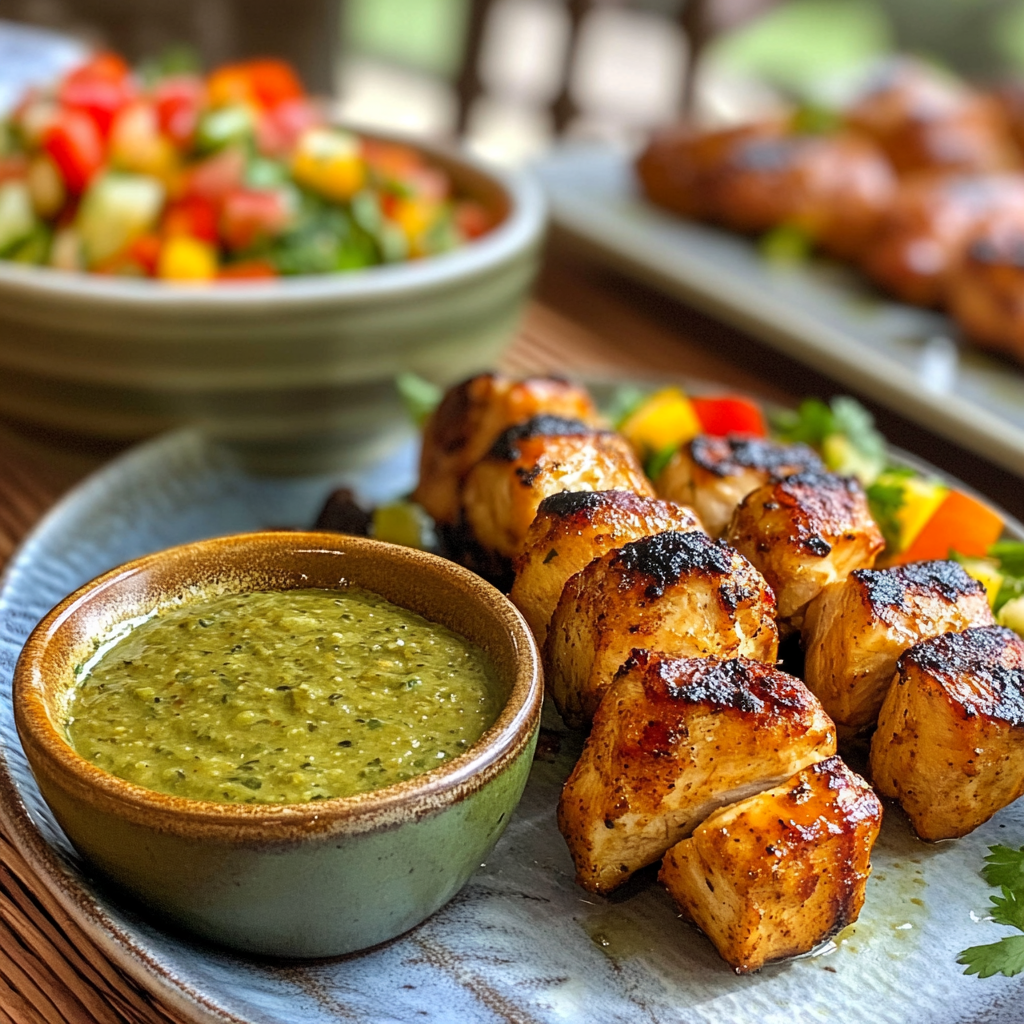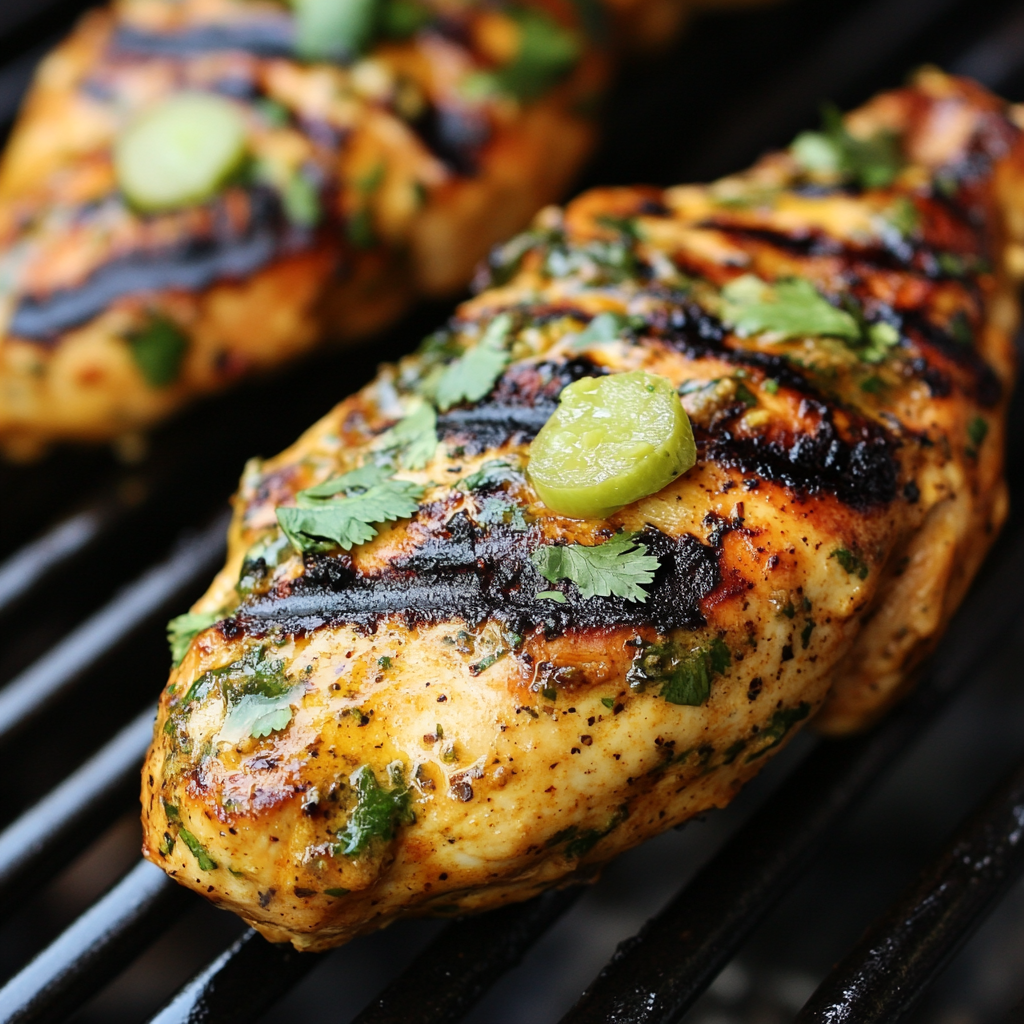Mexican cuisine is known for its bold, smoky flavors and perfectly balanced marinades, and San Antonio-style grilled Mexican chicken is no exception. This dish blends zesty citrus, aromatic spices, and just the right amount of heat to create a mouthwatering grilled chicken that is juicy, tender, and packed with authentic Tex-Mex flavor.
In this guide, you’ll learn the secrets of an incredible marinade, explore key ingredients, and follow step-by-step instructions to achieve restaurant-quality results at home. Whether you’re planning a backyard barbecue or want to enhance your weekly meals, this San Antonio grilled Mexican chicken marinade recipe is sure to become a staple in your kitchen.
The Flavors of San Antonio Cuisine
San Antonio’s culinary scene is a fusion of traditional Mexican flavors and bold Texan influences. The city’s unique blend of Tex-Mex cuisine stems from generations of Hispanic heritage, incorporating ingredients that highlight the rich, smoky, and spicy essence of Mexican cooking.
Key elements of San Antonio’s grilled chicken marinade include:
- Citrus Zing – Lime and orange juices provide acidity, breaking down proteins for a tender, flavorful bite.
- Spice & Heat – A combination of chili powders (ancho, chipotle, cayenne) gives the chicken its signature smoky warmth.
- Herbal Depth – Fresh cilantro, Mexican oregano, and cumin create an earthy, aromatic base.
- Balanced Fat & Acid – A mix of olive oil and vinegar ensures a marinade that both coats and penetrates the meat evenly.
This balance of acidity, spice, and smokiness makes San Antonio’s grilled Mexican chicken marinade stand out from others.
Essential Ingredients for the Perfect Marinade
A well-balanced marinade deeply infuses flavor while keeping the meat moist. Here’s what you’ll need:
Citrus Juices for Tenderizing
- Lime juice – Provides a sharp, fresh acidity that helps break down proteins.
- Orange juice – Adds natural sweetness and a touch of bitterness to balance flavors.
Spice Blend
- Chili powders (ancho, chipotle, cayenne) – Create heat and a deep, smoky complexity.
- Cumin – Adds an earthy, nutty warmth.
- Mexican oregano – Bolder than regular oregano, this herb enhances the authentic Tex-Mex taste.
- Paprika – Boosts color and provides a mild, sweet heat.
Aromatics & Umami Boosters
- Garlic – Fresh minced garlic adds pungency and depth.
- Onion powder – Delivers a hint of sweetness.
- Soy sauce or Worcestershire sauce – Optional but great for enhancing the umami factor.
Oils & Acids for Balance
- Olive oil – Helps coat the chicken and lock in moisture.
- Apple cider vinegar – Provides a slight tang to balance the richness of the spices.
This combination of ingredients creates a flavor-packed marinade that tenderizes while deeply infusing the chicken with authentic San Antonio-style taste.
Choosing the Right Chicken Cut
Not all chicken cuts absorb marinade the same way, so selecting the right cut for grilling is key to juiciness and tenderness.
Best Cuts for Grilling
- Boneless, skinless thighs – The most flavorful and forgiving cut, thighs retain moisture well.
- Bone-in, skin-on thighs or drumsticks – The bone adds flavor, and the skin crisps beautifully on the grill.
- Chicken breasts – Leaner but can dry out quickly if overcooked. Best when marinated longer and grilled over indirect heat.
For maximum juiciness, use bone-in thighs or drumsticks. If you prefer leaner meat, opt for marinated boneless breasts.
The Role of Acid in Tenderizing
A crucial aspect of a marinade is acid, which helps break down muscle fibers to create tender, flavorful meat.
- Lime juice and vinegar work by loosening tough proteins, making the chicken soft and juicy.
- However, too much acid for too long can cause the meat to become mushy.
Ideal Marinating Time
- Thighs & drumsticks: 4 to 8 hours for full flavor.
- Breasts: 2 to 4 hours to prevent over-tenderizing.
- Whole chicken: Overnight for the best results.
Traditional vs. Modern Marinade Methods
While some people prefer hand-mixing their marinade, others use modern tools like blenders or food processors for convenience.
Classic Homemade Method:
- Mix all ingredients in a bowl and whisk until well combined.
- Coat the chicken evenly and massage the marinade into the meat.
Blender or Food Processor Method:
- Blend all marinade ingredients until smooth for a more uniform consistency.
- This method ensures deep penetration of flavors.
Both methods deliver excellent results, so choose based on preference.
Spice Level Customization
Everyone has a different tolerance for spice, so here’s how you can adjust the heat:
- Mild Heat: Use only ancho chili powder and paprika.
- Medium Heat: Add a pinch of cayenne and smoked chipotle powder.
- Spicy Kick: Include finely chopped jalapeños or habaneros.
- Sweet Balance: A touch of honey or agave can mellow out the heat while adding depth to the marinade.
By adjusting spice and sweetness levels, you can customize this San Antonio grilled Mexican chicken marinade to suit your taste.
Marination Time & Best Practices
Proper marination ensures every bite is flavorful and juicy.
Best Practices for Maximum Flavor:
Marinate in the refrigerator – Prevents bacteria growth.
Use a zip-lock bag or airtight container – Helps coat the chicken evenly.
Turn the chicken occasionally – Ensures all sides absorb the flavors.
Never reuse marinade – If basting while grilling, reserve some fresh marinade beforehand.
Alternative Marinade Variations
For those who love experimenting with flavors, here are some delicious variations:
Smoky Chipotle Marinade
- Adds extra smokiness and heat with chipotle peppers in adobo.
Yucatán-Style Citrus Achiote Marinade
- Uses achiote paste, orange juice, and garlic for a bright, tangy flavor.
Spicy Habanero-Lime Marinade
- Infuses bold heat with habanero peppers while balancing with honey.
Each variation provides a unique twist on the San Antonio-style grilled chicken marinade.
San Antonio Grilled Mexican Chicken Marinade Recipe (Part 2)
Now that we’ve covered the essential ingredients and marination techniques, it’s time to focus on grilling methods, achieving the perfect smoky flavor, and serving the dish with delicious side options.
By following these techniques, you’ll learn how to cook juicy, flavorful grilled chicken while preserving its authentic San Antonio-style Mexican taste.
Grilling Techniques for Perfect Mexican Chicken
Grilling chicken requires precision and technique to achieve that perfect charred exterior and tender interior. Whether using a charcoal grill, gas grill, or even a grill pan, the method you choose will impact the final flavor and texture.
Direct vs. Indirect Heat Grilling
- Direct Heat: Best for boneless cuts such as thighs or breasts, cooking them quickly over high heat.
- Indirect Heat: Works well for bone-in chicken, allowing the inside to cook slowly while keeping the exterior from burning.
Best approach: Start by searing over direct heat to lock in juices, then move to indirect heat to cook evenly.
Charcoal vs. Gas Grill – Which One is Better?
- Charcoal Grill: Ideal for authentic smoky flavor, using lump charcoal or briquettes.
- Gas Grill: Offers better temperature control, but lacks the deep smokiness of charcoal grilling.
If using a gas grill, enhance the smoky flavor by adding mesquite or hickory wood chips in a smoker box.
Achieving a Smoky, Authentic Flavor
The key to restaurant-style grilled Mexican chicken is capturing the bold, smoky essence that defines traditional Tex-Mex cooking.
Ways to Enhance Smokiness:
- Use Wood Chips: Mesquite, hickory, or pecan wood chips provide a deep, smoky layer of flavor.
- Grill Over Open Flames: If using a charcoal grill, let the flames lightly kiss the chicken for charred, crispy bits.
- Add Smoked Spices: Smoked paprika or chipotle powder enhance the natural smoky taste even if using a gas grill.
- Cook with the Lid Closed: Traps the smoky aromas inside, ensuring deeper flavor absorption.
How to Prevent Chicken from Drying Out
A common grilling mistake is overcooking chicken, leading to dry, rubbery meat. Follow these strategies to maintain juiciness while achieving a beautiful char.
- Baste with Marinade: Reserve a portion of the marinade before adding raw chicken and use it for basting during grilling.
- Use a Meat Thermometer: The perfect internal temperature for grilled chicken is 165°F (74°C). Remove from the grill as soon as it reaches this temperature.
- Let the Chicken Rest: Allowing the meat to rest for five to ten minutes after grilling locks in juices before slicing.
- Avoid Pressing the Chicken: Pressing the chicken with tongs causes juices to escape, leading to dryness.
Checking for Doneness
To ensure your grilled Mexican chicken is fully cooked yet juicy, use these doneness indicators:
Meat Thermometer Method
- 165°F (74°C) for white meat (breasts).
- 175-180°F (79-82°C) for dark meat (thighs, drumsticks).
Visual and Texture Cues
- The juices run clear when the thickest part is pierced.
- The meat feels firm but not dry when pressed.
- No pink color in the center when sliced.
Serving Suggestions – What to Pair with Grilled Mexican Chicken
To create a complete Mexican meal, pair your grilled chicken with authentic side dishes that complement the marinade’s bold flavors.
Best Side Dishes
- Warm Corn or Flour Tortillas – Perfect for wrapping grilled chicken into tacos.
- Fresh Guacamole – Creamy avocado dip balances out the smoky heat.
- Homemade Salsa – Classic pico de gallo or roasted tomatillo salsa.
- Mexican Rice – Infused with tomato, garlic, and cumin for an authentic touch.
- Refried Beans or Black Beans – A hearty, protein-packed addition.
- Mexican Street Corn (Elote) – Grilled corn topped with mayo, cotija cheese, and chili powder.
- Cilantro-Lime Slaw – A crunchy, refreshing contrast to smoky grilled chicken.
Creating the Perfect Side Sauces
Adding flavorful sauces enhances the grilled Mexican chicken experience. Here are three must-try options:
Spicy Chipotle Crema
- ½ cup sour cream or Mexican crema
- One chipotle pepper in adobo, finely chopped
- One tablespoon lime juice
- ½ teaspoon smoked paprika
Tangy Tomatillo Salsa
- Five roasted tomatillos, blended
- One garlic clove
- One jalapeño, diced
- Fresh cilantro and lime juice
Cilantro-Lime Aioli
- ½ cup mayo
- One tablespoon lime juice
- One teaspoon garlic powder
- ¼ cup chopped cilantro
These sauces provide richness, acidity, and heat, making them perfect complements to grilled chicken.
Making It a Tex-Mex Feast
To turn your grilled chicken meal into a full Tex-Mex feast, incorporate the following elements:
- Melted Queso: Serve as a dip or drizzle over grilled chicken.
- Pico de Gallo: A fresh tomato, onion, and cilantro salsa for a light contrast.
- Elote (Mexican Street Corn): Grilled corn with cotija cheese, lime, and chili powder.
- Texan BBQ Fusion: Pair grilled chicken with brisket or smoked sausage for a Southern twist.
Using Leftover Grilled Chicken in Other Dishes
Leftover grilled Mexican chicken is versatile and can be repurposed into delicious new meals.
Ways to Use Leftovers
- Shredded Chicken Tacos – Reheat and stuff into warm tortillas with salsa.
- Burrito Bowls – Serve over rice with beans, avocado, and cheese.
- Mexican-Inspired Salads – Toss with romaine, black beans, and a chipotle dressing.
- Chicken Tortilla Soup – Adds depth and smokiness to a hearty soup.
- Breakfast Scramble – Combine with eggs, peppers, and cheese for a flavorful morning dish.
How to Store and Reheat for Best Flavor
To maintain the texture and flavor of grilled Mexican chicken, follow these storage and reheating methods:
- Refrigerate in an Airtight Container: Lasts up to four days.
- Freeze for Later Use: Store in a freezer-safe bag for up to three months.
- Reheat Properly:
- Oven (Best Method): Bake at 325°F (163°C) for ten to fifteen minutes.
- Stovetop: Heat over medium-low heat with a splash of broth or lime juice.
- Microwave: Cover with a damp paper towel to retain moisture.
Adjusting the Recipe for Dietary Preferences
This grilled Mexican chicken marinade recipe can be easily modified for different dietary needs.
- Keto-Friendly: Skip the orange juice and replace with extra lime and avocado oil.
- Low-Sodium: Reduce salt and opt for fresh herbs and citrus zest to enhance flavor.
- Dairy-Free: Avoid sour cream-based sauces and use avocado crema instead.
Regional Mexican Variations of Grilled Chicken
The flavors of grilled chicken vary across different regions of Mexico, each with its own unique twist.
Yucatán-Style Pollo Asado
- Uses achiote paste, orange juice, and garlic for a vibrant, tangy marinade.
- Traditionally grilled over banana leaves for added aroma.
Northern Mexico’s Dry Rub vs. Marinade Style
- In the north, chicken is often seasoned with dry chili-based rubs rather than liquid marinades.
- Smoky and spicy flavors come from guajillo and pasilla chili powders.
Veracruz-Style Grilled Chicken
- Features a citrusy, garlic-heavy marinade with oregano and cumin.
- Often served with a side of pickled onions and jalapeños.

Exploring Grilled Chicken in Tex-Mex Cuisine
San Antonio-style grilled Mexican chicken has deeply influenced Tex-Mex cuisine. This grilled dish is commonly found in:
- Fajitas – Strips of marinated chicken served with sautéed onions and peppers.
- Burritos and Tacos – Wrapped in warm tortillas with beans, rice, and fresh toppings.
- Texan BBQ Fusion – Mixed with brisket or served with smoky barbecue sauces.
Homemade grilled chicken often has more depth of flavor than restaurant versions, as it allows for custom spice levels and authentic marinades.
FAQs About Mexican Chicken Marinade
1. Can I use the marinade for other meats?
Yes, this marinade works well for beef, pork, and even shrimp. Adjust the marination time accordingly.
2. What if I don’t have a grill?
You can use a stovetop grill pan or roast the chicken in the oven at 400°F (200°C) for 25-30 minutes.
3. Can I use bottled lime juice instead of fresh?
Fresh lime juice is recommended for the best flavor, but bottled lime juice can work in a pinch.
4. How do I make this recipe spicier?
Add more chipotle, cayenne, or fresh jalapeños to the marinade.
5. What’s the best oil to use for the marinade?
Olive oil is a great option, but you can also use avocado or vegetable oil.

